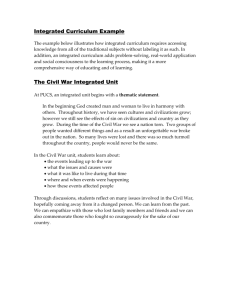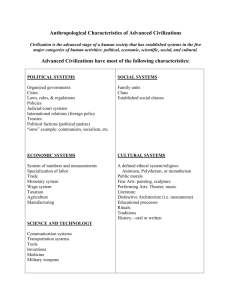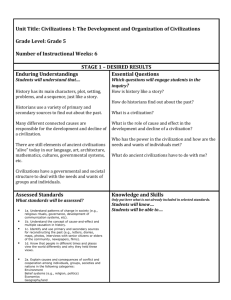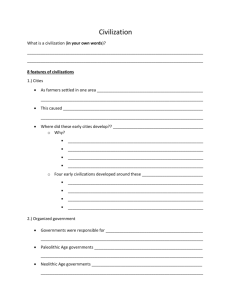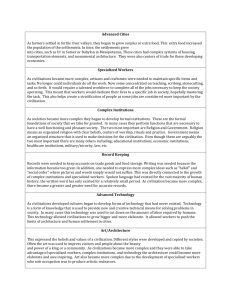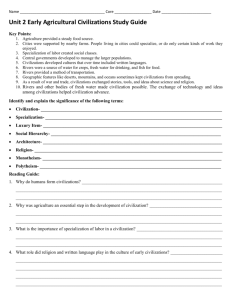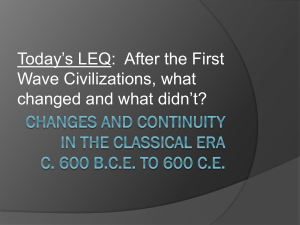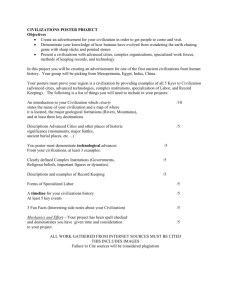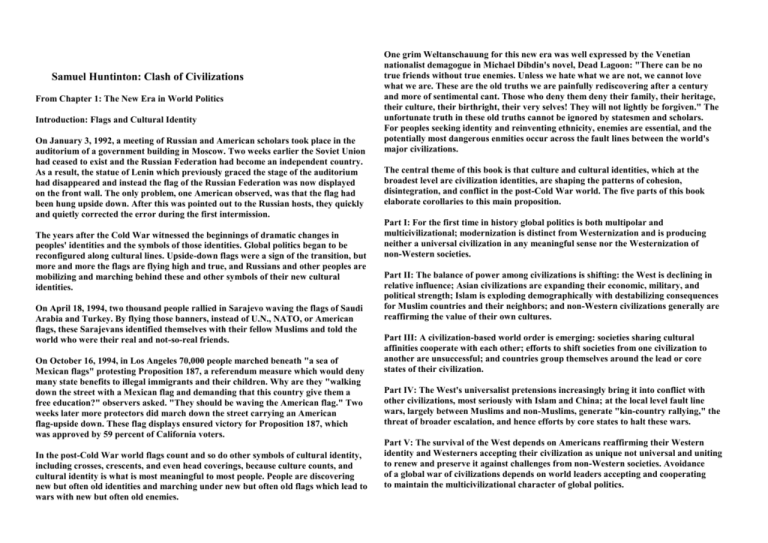
Samuel Huntinton: Clash of Civilizations
From Chapter 1: The New Era in World Politics
Introduction: Flags and Cultural Identity
On January 3, 1992, a meeting of Russian and American scholars took place in the
auditorium of a government building in Moscow. Two weeks earlier the Soviet Union
had ceased to exist and the Russian Federation had become an independent country.
As a result, the statue of Lenin which previously graced the stage of the auditorium
had disappeared and instead the flag of the Russian Federation was now displayed
on the front wall. The only problem, one American observed, was that the flag had
been hung upside down. After this was pointed out to the Russian hosts, they quickly
and quietly corrected the error during the first intermission.
The years after the Cold War witnessed the beginnings of dramatic changes in
peoples' identities and the symbols of those identities. Global politics began to be
reconfigured along cultural lines. Upside-down flags were a sign of the transition, but
more and more the flags are flying high and true, and Russians and other peoples are
mobilizing and marching behind these and other symbols of their new cultural
identities.
On April 18, 1994, two thousand people rallied in Sarajevo waving the flags of Saudi
Arabia and Turkey. By flying those banners, instead of U.N., NATO, or American
flags, these Sarajevans identified themselves with their fellow Muslims and told the
world who were their real and not-so-real friends.
On October 16, 1994, in Los Angeles 70,000 people marched beneath "a sea of
Mexican flags" protesting Proposition 187, a referendum measure which would deny
many state benefits to illegal immigrants and their children. Why are they "walking
down the street with a Mexican flag and demanding that this country give them a
free education?" observers asked. "They should be waving the American flag." Two
weeks later more protectors did march down the street carrying an American
flag-upside down. These flag displays ensured victory for Proposition 187, which
was approved by 59 percent of California voters.
In the post-Cold War world flags count and so do other symbols of cultural identity,
including crosses, crescents, and even head coverings, because culture counts, and
cultural identity is what is most meaningful to most people. People are discovering
new but often old identities and marching under new but often old flags which lead to
wars with new but often old enemies.
One grim Weltanschauung for this new era was well expressed by the Venetian
nationalist demagogue in Michael Dibdin's novel, Dead Lagoon: "There can be no
true friends without true enemies. Unless we hate what we are not, we cannot love
what we are. These are the old truths we are painfully rediscovering after a century
and more of sentimental cant. Those who deny them deny their family, their heritage,
their culture, their birthright, their very selves! They will not lightly be forgiven." The
unfortunate truth in these old truths cannot be ignored by statesmen and scholars.
For peoples seeking identity and reinventing ethnicity, enemies are essential, and the
potentially most dangerous enmities occur across the fault lines between the world's
major civilizations.
The central theme of this book is that culture and cultural identities, which at the
broadest level are civilization identities, are shaping the patterns of cohesion,
disintegration, and conflict in the post-Cold War world. The five parts of this book
elaborate corollaries to this main proposition.
Part I: For the first time in history global politics is both multipolar and
multicivilizational; modernization is distinct from Westernization and is producing
neither a universal civilization in any meaningful sense nor the Westernization of
non-Western societies.
Part II: The balance of power among civilizations is shifting: the West is declining in
relative influence; Asian civilizations are expanding their economic, military, and
political strength; Islam is exploding demographically with destabilizing consequences
for Muslim countries and their neighbors; and non-Western civilizations generally are
reaffirming the value of their own cultures.
Part III: A civilization-based world order is emerging: societies sharing cultural
affinities cooperate with each other; efforts to shift societies from one civilization to
another are unsuccessful; and countries group themselves around the lead or core
states of their civilization.
Part IV: The West's universalist pretensions increasingly bring it into conflict with
other civilizations, most seriously with Islam and China; at the local level fault line
wars, largely between Muslims and non-Muslims, generate "kin-country rallying," the
threat of broader escalation, and hence efforts by core states to halt these wars.
Part V: The survival of the West depends on Americans reaffirming their Western
identity and Westerners accepting their civilization as unique not universal and uniting
to renew and preserve it against challenges from non-Western societies. Avoidance
of a global war of civilizations depends on world leaders accepting and cooperating
to maintain the multicivilizational character of global politics.
A Multipolar, Multicivilizational World In the post-Cold War world, for the first
time in history, global politics has become multipolar and multicivilizational. During
most of human existence, contacts between civilizations were intermittent or
nonexistent. Then, with the beginning of the modern era, about A.D. 1500, global
politics assumed two dimensions. For over four hundred years, the nation states of
the West—Britain, France, Spain, Austria, Prussia, Germany, the United States, and
others—constituted a multipolar international system within Western civilization
interacted, competed, and fought wars with each other. At the same time, Western
nations also expanded, conquered, colonized, or decisively influenced every other
civilization (Map 1.1). During the Cold War global politics became bipolar and the
world was divided into three parts. A group of mostly wealthy and democratic
societies, led by the United States, was engaged in a pervasive ideological, political,
economic, and, at times, military competition with a group of somewhat poorer
communist societies associated with and led by the Soviet Union. Much of this
conflict occurred in the Third World outside these two camps, composed of countries
which often were poor, lacked political stability, were recently independent, and
claimed to be nonaligned (Map 1.2).
In the late 1980s the communist world collapsed, and the Cold War international
system became history. In the post-Cold War world, the most important distinctions
among peoples are not ideological, political, or economic. They are cultural. Peoples
and nations are attempting to answer the most basic question humans can face: Who
are we? And they are answering that question in the traditional way human beings
have answered it, by reference to the things that mean most to them. People define
themselves in terms of ancestry, religion, language, history, values, customs, and
institutions. They identify with cultural groups: tribes, ethnic groups, religious
communities, nations, and, at the broadest level, civilizations. People use politics not
just to advance their interests but also to define their identity. We know who we are
only when we know who we are not and often only when we know whom we are
against.
Nation states remain the principal actors in world affairs. Their behavior is shaped
in the past by the pursuit of power and wealth, but it is also shaped by cultural
preferences, commonalities, and differences. The most important groupings of states
are no longer the three blocs of the Cold War but rather the world's seven or eight
major civilizations (Map 1.3). Non-Western societies, particularly in East Asia, are
developing their economic wealth and creating the basis for enhanced military power
and political influence. As their power and self-confidence increase, non-Western
societies increasingly assert their own cultural values and reject those "imposed" on
them by the West. The "international system of the twenty-first century," Henry
Kissinger has noted, ". . . will contain at least six major powers—the United States,
Europe, China, Japan, Russia, and probably India—as well as a multiplicity of
mediumsized and smaller countries." Kissinger's six major powers belong to five very
different civilizations, and in addition there are important Islamic states whose
strategic locations, large populations, and/or oil resources make them influential in
world affairs. In this new world, local politics is the politics of ethnicity; global politics
is the politics of civilizations. The rivalry of the superpowers is replaced by the clash
of civilizations.
In this new world the most pervasive, important, and dangerous conflicts will not be
between social classes, rich and poor, or other economically defined groups, but
between peoples belonging to different cultural entities. Tribal wars and ethnic
conflicts will occur within civilizations. Violence between states and groups from
different civilizations, however, carries with it the potential for escalation as other
states and groups from these civilizations rally to the support of their "kin countries."
The bloody clash of clans in Somalia poses no threat of broader conflict. The bloody
clash of tribes in Rwanda has consequences for Uganda, Zaire, and Burundi but not
much further. The bloody clashes of civilizations in Bosnia, the Caucasus, Central
Asia, or Kashmir could become bigger wars. In the Yugoslav conflicts, Russia
provided diplomatic support to the Serbs, and Saudi Arabia, Turkey, Iran, and Libya
provided funds and arms to the Bosnians, not for reasons of ideology or power
politics or economic interest but because of cultural kinship. "Cultural conflicts,"
Vaclav Havel has observed, "are increasing and are more dangerous today than at
any time in history," and Jacques Delors agreed that "future conflicts will be sparked
by cultural factors rather than economics or ideology." And the most dangerous
cultural conflicts are those along the fault lines between civilizations.
In the post-Cold War world, culture is both a divisive and a unifying force. People
separated by ideology but united by culture come together, as the two Germanys did
and as the two Koreas and the several Chinas are beginning to. Societies united by
ideology or historical circumstance but divided by civilization either come apart, as
did the Soviet Union, Yugoslavia, and Bosnia, or are subjected to intense strain, as is
the case with Ukraine, Nigeria, Sudan, India, Sri Lanka, and many others. Countries
with cultural affinities cooperate economically and politically. International
organizations based on states with cultural commonality, such as the European
Union, are far more successful than those that attempt to transcend cultures. For
forty-five years the Iron Curtain was the central dividing line in Europe. That line has
moved several hundred miles east. It is now the line separating the peoples of
Western Christianity, on the one hand, from Muslim and Orthodox peoples on the
other.
The philosophical assumptions, underlying values, social relations, customs, and
overall outlooks on life differ significantly among civilizations. The revitalization of
religion throughout much of the world is reinforcing these cultural differences.
Cultures can change, and the nature of their impact on politics and economics can
vary from one period to another. Yet the major differences in political and economic
development among civilizations are clearly rooted in their different cultures. East
Asian economic success has its source in East Asian culture, as do the difficulties
East Asian societies have had in achieving stable democratic political systems.
Islamic culture explains in large part the failure of democracy to emerge in much of
the Muslim world. Developments in the postcommunist societies of Eastern Europe
and the former Soviet Union are shaped by their civilizational identities. Those with
Western Christian heritages are making progress toward economic development and
democratic politics; the prospects for economic and political development in the
Orthodox countries are uncertain; the prospects in the Muslim republics are bleak.
The West is and will remain for years to come the most powerful civilization. Yet its
power relative to that of other civilizations is declining. As the West attempts to
assert its values and to protect its interests, non-Western societies confront a choice.
Some attempt to emulate the West and to join or to "bandwagon" with the West.
Other Confucian and Islamic societies attempt to expand their own economic and
military power to resist and to "balance" against the West. A central axis of
post-Cold War world politics is thus the interaction of Western power and culture
with the power and culture of non-Western civilizations.
In sum, the post-Cold War world is a world of seven or eight major civilizations.
Cultural commonalities and differences shape the interests, antagonisms, and
associations of states. The most important countries in the world come
overwhelmingly from different civilizations. The local conflicts most likely to escalate
into broader wars are those between groups and states from different civilizations.
The predominant patterns of political and economic development differ from
civilization to civilization. The key issues on the international agenda involve
differences among civilizations. Power is shifting from the long predominant West to
non-Western civilizations. Global politics has become multipolar and
multicivilizational.
Copyright © 1996 by Samuel P. Huntington
Copyright © 1995-1997 BITU Productions All rights reserved. Do not duplicate
or redistribute in any form.
We respect your privacy.

